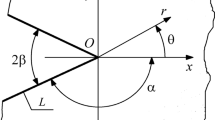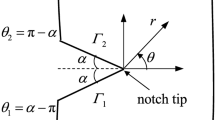Abstract
In this paper we study the deformation of a body with a notch subject to an anti-plane state of stress within the context of a new class of elastic models. These models stem as approximations of constitutive response functions for an elastic body that is defined within the context of an implicit constitutive relation between the stress and the deformation gradient. Gum metal and many metallic alloys are described well by such constitutive relations. We consider the state of anti-plane stress of a body with a smoothened V-notch within the context of constitutive relations for the linearized strain in terms of a power-law for the stretch. The problem is solved numerically and the convergence and the stability of the solution is studied.












Similar content being viewed by others
Notes
Noll [42] later generalized the concept of his definition of a Simple Material but not to include implicit relationships. We shall not get into a discussion of the same here.
Rajagopal [55] classified the material symmetry possessed by the sub-classes of bodies whose histories of the stress, deformation gradient, density, etc., are given in terms of an implicit constitutive relations.
Bulíček et al. [7] study several mathematical aspects concerning strain limiting bodies.
Since we consider constitutive relations of the type (4b), the anti-plane stress state is equivalent to the classical definition of anti-plane strain.
We are not using the same model and obtaining two different sets of values for the material parameters under two loading conditions. The NLB and NLS models are two different models that provide equally good fits. We used different experiments to obtain the material parameters for the two different models. These different sets of values fit the data equally well for the both the experiments. Which of these two models better explains the response of the body can only be determined by having other experiments against which these models can be corroborated. Such experiments are not available at the present time.
References
Alnæs, M., Blechta, J., Hake, J., Johansson, A., Kehlet, B., Logg, A., Richardson, C., Ring, J., Rognes, M.E., Wells, G.N.: The FEniCS project version 1.5. Arch. Numer. Softw. 3(100), 9–23 (2015). https://doi.org/10.11588/ans.2015.100.20553
Beck, L., Bulíček, M., Málek, J., Süli, E.: On the existence of integrable solutions to nonlinear elliptic systems and variational problems with linear growth. Arch. Ration. Mech. Anal. 225(2), 717–769 (2017). https://doi.org/10.1007/s00205-017-1113-4
Blechta, J., Málek, J., Rajagopal, K.R.: On the classification of incompressible fluids (2019)
Bonito, A., Girault, V., Süli, E.: Finite element approximation of a strain-limiting elastic model. arXiv:1805.04006 [math.NA] (2018)
Bulíček, M., Gwiazda, P., Málek, J., Rajagopal, K.R., Świerczewska-Gwiazda, A.: On flows of fluids described by an implicit constitutive equation characterized by a maximal monotone graph. In: Robinson, J.C., Rodrigo, J.L., Sadowski, W. (eds.) Mathematical Aspects of Fluid Mechanics, pp. 23–51. Cambridge University Press, Cambridge (2012). https://doi.org/10.1017/cbo9781139235792.003
Bulíček, M., Gwiazda, P., Málek, J., Świerczewska-Gwiazda, A.: On unsteady flows of implicitly constituted incompressible fluids. SIAM J. Math. Anal. 44(4), 2756–2801 (2012). https://doi.org/10.1137/110830289
Bulíček, M., Málek, J., Rajagopal, K.R., Süli, E.: On elastic solids with limiting small strain: modelling and analysis. EMS Surv. Math. Sci. 1(2), 283–332 (2014). https://doi.org/10.4171/emss/7
Bulíček, M., Gwiazda, P., Málek, J., Świerczewska-Gwiazda, A.: On steady flows of incompressible fluids with implicit power-law-like rheology. Adv. Calc. Var. 2(2), 109–136 (2009). https://doi.org/10.1515/ACV.2009.006
Bulíček, M., Gwiazda, P., Málek, J., Świerczewska-Gwiazda, A.: On scalar hyperbolic conservation laws with a discontinuous flux. Math. Models Methods Appl. Sci. 21(1), 89–113 (2011). https://doi.org/10.1142/S021820251100499X
Bulíček, M., Málek, J.: On unsteady internal flows of Bingham fluids subject to threshold slip on the impermeable boundary. In: Advances in Mathematical Fluid Mechanics, pp. 135–156. Birkhäuser, Basel (2016). https://doi.org/10.1007/978-3-0348-0939-9_8
Bulíček, M., Málek, J.: Internal flows of incompressible fluids subject to stick-slip boundary conditions. Vietnam J. Math. 45(1–2), 207–220 (2017). https://doi.org/10.1007/s10013-016-0221-z
Bulíček, M., Málek, J., Rajagopal, K.R.: On Kelvin-Voigt model and its generalizations. Evol. Equ. Control Theory 1(1), 17–42 (2012). https://doi.org/10.3934/eect.2012.1.17
Bulíček, M., Málek, J., Rajagopal, K.R., Walton, J.: Existence of solutions for the anti-plane stress for a new class of “strain-limiting” elastic bodies. Calc. Var. Partial Differ. Equ. 54(2), 2115–2147 (2015). https://doi.org/10.1007/s00526-015-0859-5
Bulíček, M., Málek, J., Süli, E.: Analysis and approximation of a strain-limiting nonlinear elastic model. Math. Mech. Solids 20(1), 92–118 (2015). https://doi.org/10.1177/1081286514543601
Bustamante, R., Rajagopal, K.R.: On a new class of electroelastic bodies, I. Proc. R. Soc. A, Math. Phys. Eng. Sci. 469(2149), 20120521 (2012). https://doi.org/10.1098/rspa.2012.0521
Bustamante, R., Rajagopal, K.R.: On a new class of electro-elastic bodies, II: boundary value problems. Proc. R. Soc. A, Math. Phys. Eng. Sci. 469(2155), 20130106 (2013). https://doi.org/10.1098/rspa.2013.0106
Bustamante, R., Rajagopal, K.R.: Implicit constitutive relations for nonlinear magnetoelastic bodies. Proc. R. Soc. A, Math. Phys. Eng. Sci. 471(2175), 20140959 (2015). https://doi.org/10.1098/rspa.2014.0959
Cauchy, A.L.B.: Recherches sur l’équilibre et le mouvement intérieur des corps solides ou fluides, élastiques ou non élastiques. In: Bulletin de la Société Philomatique, pp. 9–13 (1823)
Coleman, B.D., Noll, W.: An approximation theorem for functionals, with applications in continuum mechanics. Arch. Ration. Mech. Anal. 6(1), 355–370 (1960)
COMSOL AB: Comsol multiphysics user’s guide. http://www.comsol.com (2008)
Devendiran, V.K., Sandeep, R.K., Kannan, K., Rajagopal, K.R.: A thermodynamically consistent constitutive equation for describing the response exhibited by several alloys and the study of a meaningful physical problem. Int. J. Solids Struct. 108, 1–10 (2017). https://doi.org/10.1016/j.ijsolstr.2016.07.036
Diening, L., Kreuzer, C., Süli, E.: Finite element approximation of steady flows of incompressible fluids with implicit power-law-like rheology. SIAM J. Numer. Anal. 51(2), 984–1015 (2013)
Ebmeyer, C., Liu, S.W.: Quasi-norm interpolation error estimates for the piecewise linear finite element approximation of p-Laplacian problems. Numer. Math. 100(2), 233–258 (2005). https://doi.org/10.1007/s00211-005-0594-5
Feireisl, E., Liao, X., Málek, J.: Global weak solutions to a class of non-Newtonian compressible fluids. Math. Methods Appl. Sci. 38(16), 3482–3494 (2015). https://doi.org/10.1002/mma.3432
Gou, K., Mallikarjuna, M., Rajagopal, K.R., Walton, J.R.: Modeling fracture in the context of a strain-limiting theory of elasticity: a single plane-strain crack. Int. J. Eng. Sci. 88, 73–82 (2015). https://doi.org/10.1016/j.ijengsci.2014.04.018
Itou, H., Kovtunenko, V.A., Rajagopal, K.R.: Nonlinear elasticity with limiting small strain for cracks subject to non-penetration. Math. Mech. Solids (2016). https://doi.org/10.1177/1081286516632380
Kreuzer, C., Süli, E.: Adaptive finite element approximation of steady flows of incompressible fluids with implicit power-law-like rheology. ESAIM: M2AN 50(5), 1333–1369 (2016). https://doi.org/10.1051/m2an/2015085
Kulvait, V., Málek, J., Rajagopal, K.R.: Anti-plane stress state of a plate with a V-notch for a new class of elastic solids. Int. J. Fract. 179(1–2), 59–73 (2013). https://doi.org/10.1007/s10704-012-9772-5
Kulvait, V.: Mathematical analysis and computer simulations of deformation of nonlinear elastic bodies in the small strain range. PhD thesis. Charles University, Faculty of Mathematics and Physics (2017)
Kulvait, V., Málek, J., Rajagopal, K.R.: Modeling gum metal and other newly developed titanium alloys within a new class of constitutive relations for elastic bodies. Arch. Mech. 69(1), 223–241 (2017)
Le Roux, C., Rajagopal, K.R.: Shear flows of a new class of power-law fluids. Appl. Math. 58(2), 153–177 (2013). https://doi.org/10.1007/s10492-013-0008-4
Logg, A., Mardal, K.A., Wells, G.: Automated Solution of Differential Equations by the Finite Element Method: The FEniCS Book. Springer, New York (2012)
Málek, J.: Mathematical properties of flows of incompressible power-law-like fluids that are described by implicit constitutive relations. Electron. Trans. Numer. Anal. 31, 110–125 (2008)
Málek, J., Průša, V.: Derivation of equations for continuum mechanics and thermodynamics of fluids. In: Giga, Y., Novotny, A. (eds.) Handbook of Mathematical Analysis in Mechanics of Viscous Fluids, pp. 1–70. Springer, Cham (2016)
Málek, J., Průša, V., Rajagopal, K.R.: Generalizations of the Navier-Stokes fluid from a new perspective. Int. J. Eng. Sci. 48(12), 1907–1924 (2010). https://doi.org/10.1016/j.ijengsci.2010.06.013
Málek, J., Rajagopal, K.R.: Compressible generalized Newtonian fluids. Z. Angew. Math. Phys. 61(6), 1097–1110 (2010). https://doi.org/10.1007/s00033-010-0061-8
Maringová, E., Žabenský, J.: On a Navier-Stokes-Fourier-like system capturing transitions between viscous and inviscid fluid regimes and between no-slip and perfect-slip boundary conditions. Nonlinear Anal., Real World Appl. 41, 152–178 (2018)
Montero, S., Bustamante, R., Ortiz-Bernardin, A.: A finite element analysis of some boundary value problems for a new type of constitutive relation for elastic bodies. Acta Mech. 227(2), 601–615 (2016). https://doi.org/10.1007/s00707-015-1480-6
Noll, W.: On the continuity of the solid and fluid states. J. Ration. Mech. Anal. 4, 3–81 (1955)
Noll, W.: On the Foundation of the Mechanics of Continuous Media. Technical Report Series. Books on Demand (1957)
Noll, W.: A mathematical theory of the mechanical behavior of continuous media. Arch. Ration. Mech. Anal. 2(1), 197–226 (1958)
Noll, W.: A new mathematical theory of simple materials. Arch. Ration. Mech. Anal. 48(1), 1–50 (1972). https://doi.org/10.1007/BF00253367
Ortiz, A., Bustamante, R., Rajagopal, K.R.: A numerical study of a plate with a hole for a new class of elastic bodies. Acta Mech. 223(9), 1971–1981 (2012). https://doi.org/10.1007/s00707-012-0690-4
Ortiz, A., Bustamante, R., Rajagopal, K.R.: A numerical study of elastic bodies that are described by constitutive equations that exhibit limited strains. Int. J. Solids Struct. 51(3), 875–885 (2014). https://doi.org/10.1016/j.ijsolstr.2013.11.014
Perlácová, T., Průša, V.: Tensorial implicit constitutive relations in mechanics of incompressible non-Newtonian fluids. J. Non-Newton. Fluid Mech. 216, 13–21 (2015). https://doi.org/10.1016/j.jnnfm.2014.12.006
Průša, V., Rajagopal, K.R.: On implicit constitutive relations for materials with fading memory. J. Non-Newton. Fluid Mech. 181, 22–29 (2012)
Rajagopal, K.: A note on the linearization of the constitutive relations of non-linear elastic bodies. Mech. Res. Commun. (2017)
Rajagopal, K., Srinivasa, A.: On a class of non-dissipative materials that are not hyperelastic. Proc. R. Soc. A, Math. Phys. Eng. Sci. 465(2102), 493–500 (2009). https://doi.org/10.1098/rspa.2008.0319
Rajagopal, K.R.: On implicit constitutive theories. Appl. Math. 48(4), 279–319 (2003)
Rajagopal, K.R.: On implicit constitutive theories for fluids. J. Fluid Mech. 550, 243–249 (2006)
Rajagopal, K.R.: The elasticity of elasticity. Z. Angew. Math. Phys. 58(2), 309–317 (2007)
Rajagopal, K.R.: Conspectus of concepts of elasticity. Math. Mech. Solids 16(5), 536–562 (2011). https://doi.org/10.1177/1081286510387856
Rajagopal, K.R.: A new development and interpretation of the Navier–Stokes fluid which reveals why the “Stokes assumption” is inapt. Int. J. Non-Linear Mech. 50, 141–151 (2013). https://doi.org/10.1016/j.ijnonlinmec.2012.10.007
Rajagopal, K.R.: On the nonlinear elastic response of bodies in the small strain range. Acta Mech. 225(6), 1545–1553 (2014). https://doi.org/10.1007/s00707-013-1015-y
Rajagopal, K.R.: A note on the classification of anisotropy of bodies defined by implicit constitutive relations. Mech. Res. Commun. 64, 38–41 (2015). https://doi.org/10.1016/j.mechrescom.2014.11.005
Rajagopal, K.R., Saccomandi, G.: The mechanics and mathematics of the effect of pressure on the shear modulus of elastomers. Proc. R. Soc. A, Math. Phys. Eng. Sci. 465(2112), 3859–3874 (2009). https://doi.org/10.1098/rspa.2009.0416
Rajagopal, K.R., Saccomandi, G.: A novel approach to the description of constitutive relations. Frontiers in Materials 3 (2016). https://doi.org/10.3389/fmats.2016.00036
Rajagopal, K.R., Srinivasa, A.R.: On the response of non-dissipative solids. Proc. R. Soc. A, Math. Phys. Eng. Sci. 463(2078), 357–367 (2006). https://doi.org/10.1098/rspa.2006.1760
Rajagopal, K.R., Srinivasa, A.R.: Inelastic response of solids described by implicit constitutive relations with nonlinear small strain elastic response. Int. J. Plast. 71, 1–9 (2015). https://doi.org/10.1016/j.ijplas.2015.02.007
Rajagopal, K.R., Walton, J.R.: Modeling fracture in the context of a strain-limiting theory of elasticity: a single anti-plane shear crack. Int. J. Fract. 169(1), 39–48 (2011). https://doi.org/10.1007/s10704-010-9581-7
Rajagopal, K.R., Zappalorto, M.: Bodies described by non-monotonic strain-stress constitutive equations containing a crack subject to anti-plane shear stress. Int. J. Mech. Sci. 149, 494–499 (2018). https://doi.org/10.1016/j.ijmecsci.2017.07.060
Süli, E., Tscherpel, T.: Fully discrete finite element approximation of unsteady flows of implicitly constituted incompressible fluids. arXiv:1804.02264 (2018)
Truesdell, C., Moon, H.: Inequalities sufficient to ensure semi-invertibility of isotropic functions. J. Elas. 5(34) (1975)
Zappalorto, M., Berto, F., Rajagopal, K.R.: On the anti-plane state of stress near pointed or sharply radiused notches in strain limiting elastic materials: closed form solution and implications for fracture assessments. Int. J. Fract. 199(2), 169–184 (2016). https://doi.org/10.1007/s10704-016-0102-1
Acknowledgements
Josef Málek thanks the Czech Science Foundation for support through the project 18-12719S. K.R. Rajagopal thanks the Office of Naval Research for support of this work.
Author information
Authors and Affiliations
Corresponding author
Additional information
Dedicated to the memory of Professor Walter Noll
Publisher’s Note
Springer Nature remains neutral with regard to jurisdictional claims in published maps and institutional affiliations.
Rights and permissions
About this article
Cite this article
Kulvait, V., Málek, J. & Rajagopal, K.R. The State of Stress and Strain Adjacent to Notches in a New Class of Nonlinear Elastic Bodies. J Elast 135, 375–397 (2019). https://doi.org/10.1007/s10659-019-09724-0
Received:
Published:
Issue Date:
DOI: https://doi.org/10.1007/s10659-019-09724-0




